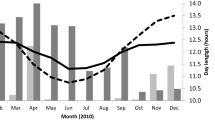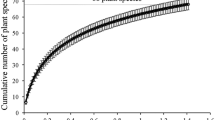Abstract
I describe the diet and feeding behavior of silver leaf monkeys (Trachypithecus auratus sondaicus) in the Pangandaran Nature Reserve, West Java, Indonesia, and compare a group living in old secondary rain forest with a group living in mixed plantation/secondary forest to determine intraspecific variation in feeding behavior and the importance of the plantation species in the diet of the monkeys. Young leaves and leaf buds made up slightly less than half of their diets, with both groups showing a preference for a few species when seasonally available. Fruits and flowers of a few species were also preferentially selected when available. These included sweet, fleshy fruits, which most other colobines tend to avoid. Young leaf intake was greatest in months when fruit intake was low. Mature leaves were rarely eaten. Both groups spent approximately 20% of feeding time foraging on Moraceae species. Differences in the diet of the two groups were related largely to differences in vegetational composition and the availability and abundance of food items for the species common to both sites. Teak (Tectona grandis) was the top food species of the group living in mixed plantation/secondary forest, with the midribs of young leaves preferentially selected. Young leaves ofT. grandis, available throughout the study, provided a staple food and were eaten when preferred foods were scarce. More favored food items were available to the group living in old secondary forest, though none was a staple food.
Similar content being viewed by others
References
Aldrich-Blake, F. P. G. (1980). Long-tailed macaques. In Chivers, D. J. (ed.),Malayan Forest Primates, Plenum Press, London, pp. 147–165.
Altmann, J. (1974). Observational study of behaviour: Sampling methods.Behaviour 49: 227–267.
Anonymous (1981). Gross and net primary production and growth parameters. InTropical Forest Ecosystems (UNESCO/UNDP/FAO), UNESCO, Paris, pp. 233–248.
Bauchop, T., and Martucci, R. W. (1968). Ruminant-like digestion of the langur monkey.Science 161: 698–700.
Bennett, E. L. (1983).The Banded Langur: Ecology of a Colobine in West Malaysian Rain-Forest, Ph.D. thesis, University of Cambridge, Cambridge.
Bennett, E. L., and Sebastian, A. C. (1988). Social organization and ecology of proboscis monkeys (nasalis larvatus) in mixed coastal forest in Sarawak.Int. J. Primatol. 9: 233–255.
Blower, J. H., Wind, J., and Mulyana, Y. (1977).Proposed Penanjung Pangandaran Reserve Management Plan 1977–1981. Field Report of UNDP/FAO Nature Conservation and Wildlife Management Project, Food and Agriculture Organization of the United Nations, Rome.
Brotoisworo, E., and Dirgayusa, I. W. A. (1991). Ranging and feeding behavior ofPresbytis cristata in the Pangandaran nature reserve, West Java, Indonesia. In Ehara, A., Kimura, T., Takenaka, O., and Iwamoto, M. (eds.),Proceedings of the XIIIth Congress of the International Primatological Society, Nagoya and Kyoto, 18–24 July 1990, Elsevier Science, The Hague.
Caldecott, J. O. (1983). an Ecological Study of the Pig-Tailed Macaque in Peninsular Malaysia, Ph.D. thesis, University of Cambridge, Cambridge.
Cant, J. G. H. (1980). What limits primates?Primates 21: 538–544.
Chapman, C. A., and Chapman, L. J. (1990). Dietary variability in primate populations.Primates 31: 121–128.
Chivers, D. J. (1974). The siamang in Malaya: A field study of a primate in a tropical rain forest.Contrib. Primatol. 4: 1–335.
Chivers, D. J., and Hladik, C. M. (1984). Diet and gut morphology in primates. In Chivers, D. J., Wood, B. A., and Bilsborough, A. (eds.),Food Acquisition and Processing in Primates, Plenum Press, London, pp. 213–230.
Clutton-Brock, T. H. (1975). Feeding behaviour of red colobus and black and white colobus in East Africa.Folia Primatol. 23: 165–207.
Corlett, R. T. (1987). The phenology ofFicus fistulosa in Singapore.Biotropica 19: 122–124.
Curtin, S. H. (1980). Dusky and banded leaf monkeys. In Chivers, D. J. (ed.),Malayan Forest Primates, Plenum Press, London, pp. 107–145.
Davies, A. G. (1984).An Ecological Study of the Red Leaf Monkey (Presbytis rubicunda)in the Dipterocarp Forest of Northern Borneo, Ph.D. thesis, University of Cambridge, Cambridge.
Davies, G. (1991). Seed-eating by red leaf monkeys (Presbytis rubicunda) in dipterocarp forest of Northern Borneo.Int. J. Primatol. 12: 119–144.
Davies, A. G., and Baillie, I. C. (1988). Soil-eating by red leaf monkeys (Presbytis rubicunda) in Sabah, Northern Borneo.Biotropica 20: 252–258.
Davies, A. G., Bennett, E. L., and waterman, P. G. (1988). Food selection by two South-east Asian colobine monkeys (Presbytis rubicunda andPresbytis melalophos) in relation to plant chemistry.Biol. J. Linn. Soc. 34: 33–56.
Freeland, W. J., and Janzen, D. H. (1974). Strategies in herbivory by mammals: The role of plant secondary compounds.Am. Nat. 108: 269–289.
Gatinot, B. L. (1977). Le regime alimentaire du Colobe bai au Senegal.Mammalia 41: 373–402.
Gittins, S. P., and Raemakers, J. J. (1980). Siamang, lar and agile gibbons. In Chivers, D. J. (ed.),Malayan Forest Primates, Plenum Press, London, pp. 63–105.
Goltenboth, R. (1976). Nonhuman primates (apes, monkeys and prosiminas). In Klos, H.-G., and Lang, E. M. (eds.),The Handbook of Zoo Medicine (translation), Van Nostrand Reinhold, New York, pp. 46–85.
Gurmaya, K. J. (1986). Ecology and behavior ofPresbytis thomasi in northern Sumatra.Primates 27: 151–172.
Gysel, L. W., and Lyon, L. J. (1980). Habitat analysis and evaluation. In Schemnitz, S. D. (ed.),Wildlife Management Techniques Manual, 4th ed., rev., Wildlife Society, Washington, DC, pp. 305–327.
Harrison, M. J. S. (1986). Feeding ecology of black colobus,Colobus satanas, in central Gabon. In Else, J. G., and Lee, P. C. (eds.),Primate Ecology and Conservation, Cambridge University Press, Cambridge, pp. 31–37.
Hladik, C. M. (1977). A comparative study of the feeding strategies of two sympatric species of leaf monkeys:Presbytis senex andPresbytis entellus. In Clutton-Brock, T. H. (ed.),Primate Ecology: Studies of Feeding and Ranging Behaviour in Lemurs, Monkeys and Apes, Academic Press, London, pp. 323–353.
Hladik, C. M., and Hladik, A. (1972). Disponibilites alimentaires et domaines vitaux des primates a Ceylan.Terre Vie 26: 149–215.
Homewood, K. M. (1978). Feeding strategy of the Tana mangabey (Cercocebus galeritus galeritus) (Mammalia: Primates).J. Zool. (London) 186: 375–391.
Janis, C. (1976). The evolutionary strategy of the Equidae and the origins of rumen and caecal digestion.Evolution 30: 757–774.
Janzen, D. H. (1979). How to be a fig.Annu. Rev. Ecol. Syst. 10: 13–52.
Kavanagh, M. (1978). The diet and feeding behaviour ofCercopithecus aethiops tantalus.Folia Primatol. 30: 30–63.
Kool, K. M. (1989).Behavioural Ecology of the Silver Leaf Monkey, Trachypithecus auratus sondaicus,in the Pangandaran Nature Reserve, West Java, Indonesia, Ph.D. thesis, University of New South Wales, Sydney.
MacKinnon, J. (1974). The behaviour and ecology of wild orang utans (Pongo pygmaeus).Anim. Behav. 22: 3–74.
MacKinnon, J. R., and MacKinnon, K. S. (1978). Comparative feeding ecology of six primates in west Malaysia. In Chivers, D. J., and Herbert, J. (eds.),Recent Advances in Primatology, Vol. 1, Behaviour, Academic Press, London, pp. 305–321.
Mah, Y. L. (1980).Ecology and Behaviour of Macaca fascicularis, Ph.D. thesis, University of Malaya, Kuala Lumpur.
Marsh, C. W. (1978).Ecology and Social Organization of the Tana River Red Colobus, Colobus badius rufomitratus, Ph.D. thesis, University of Bristol, Bristol.
Marsh, C. W. (1979). Comparative aspects of social organization in the Tana River red colobus,Colobus badius rufomitratus.Z. Tierpsychol. 51: 337–362.
Marsh, C. W. (1981). Diet choice among red colobus (Colobus badius rufomitratus) on the Tana River, Kenya.Folia Primatol. 35: 147–178.
Marsh, C. W., and Wilson, W. L. (1981).A Survey of Primates in Peninsular Malaysian Forest, Universiti Kebangsaan Malaysia, Selangor, and University of Cambridge, Cambridge.
McKey, D. B. (1975). The ecology of coevolved seed dispersal systems. In Gilbert, L. E., and Raven, P. H. (eds.),Coevolution of Animals and Plants, University Press, Texas, pp. 159–191.
McKey, D. B. (1978). Soils, vegetation and seed eating by black colobus monkeys. In Montgomery, G. G. (ed.),The Ecology of Arboreal Folivores, Smithsonian Institution Press, Washington, DC, pp. 423–437.
McKey, D. B., and Waterman, P. G. (1982). Ranging behavior of a group of black colobus (Colobus satanas) in the Douala-Edea Reserve, Cameroon.Folia Primatol. 39: 264–304.
McKey, D. B., Gartlan, J. S., Waterman, P. G., and Choo, G. M. (1981). Food selection by black colobus monkeys (Colobus satanas) in relation to plant chemistry.Biol. J. Linn. Soc. 16: 115–146.
Medway, Lord (1972). Phenology of a tropical rain forest in Malaya.Biol. J. Linn. Soc. 4: 117–146.
Napier, P. H. (1985).Catalogue of Primates in the British Museum (Natural History) and Elsewhere in the British Isles, Part III: Family Cercopithecidae, Subfamily Colobinae, British Museum (Natural History), London.
Oates, J. F. (1977). The guereza and its food. In Clutton-Brock, T. H. (ed.),Primate Ecology: Studies of Feeding and Ranging Behaviour in Lemurs, Monkeys and Apes, Academic Press, London, pp. 275–321.
Oates, J. F. (1988). The diet of the olive colobus monkey,Procolobus verus, in Sierra Leone.Int. J. Primatol. 9: 457–478.
Oates, J. F., Waterman, P. G., and Choo, G. M. (1980). Food selection by the South Indian leaf-monkey,Presbytis johnii, in relation to leaf chemistry.Oecologia (Berlin) 45: 45–56.
Raemaekers, J. J. (1977).Gibbons and Trees: Comparative Ecology of the Siamang and Lar Gibbons, Ph.D. thesis, University of Cambridge, Cambridge.
Roonwal, M. L., and Mohnot, S. M. (1977).Primates of South Asia. Ecology, Sociobiology and Behavior, Harvard University Press, Cambridge.
Ruhiyat, Y. (1983). Socio-ecological study ofPresbytis aygula in west Java.Primates 24: 344–359.
Schoener, T. W. (1971). Theory of feeding strategies.Annu. Rev. Ecol. Syst. 11: 369–403.
Stanford, C. B. (1991). The diet of the capped langur (Presbytis pileata) in a moist deciduous forest in Bangladesh.Int. J. Primatol. 12: 199–216.
Struhsaker, T. T. (1975).The Red Colobus Monkey, University of Chicago Press, Chicago.
Struhsaker, T. T., and Leland, L. (1979). Socioecology of five sympatric monkey species in the Kibale Forest, Uganda. In Rosenblatt, J. S., Hinde, R. A., Beer, A., and Busnel, M. C. (eds.),Advances in the Study of Behavior, Vol. 9, Academic Press, New York, pp. 159–228.
Waser, P. M. (1977). Feeding, ranging and group size in the mangabeyCercocebus albigena. In Clutton-Brock, T. H. (ed.),Primate Ecology: Studies of Feeding and Ranging Behaviour in Lemurs, Monkeys and Apes, Academic Press, London, pp. 183–221.
Waterman, P. G. (1984). Food acquisition and processing by primates as a function of plant chemistry. In Chivers, D. J., Wood, B. A., and Bilsborough, A. (eds.),Food Acquisition and Processing by Primates, Plenum Press, New York, pp. 177–211.
Waterman, P. G., Ross, J. A. M., Bennett, E. L., and Davies, A. G. (1988). A comparison of the floristics and leaf chemistry of the tree flora in two Malaysian rain forests and the influence of leaf chemistry on populations of colobine monkeys in the Old World.Biol. J. Linn. Soc. 34: 1–32.
Weitzel, V., and Groves, C. P. (1985). The nomenclature and taxonomy of the colobine monkeys of Java.Int. J. Primatol. 6: 399–409.
Yeager, C. Y. (1989). Feeding ecology of the proboscis monkey (Nasalis larvatus).Int. J. Primatol. 10: 497–530.
Author information
Authors and Affiliations
Rights and permissions
About this article
Cite this article
Kool, K.M. The diet and feeding behavior of the silver leaf monkey (Trachypithecus auratus sondaicus) in Indonesia. International Journal of Primatology 14, 667–700 (1993). https://doi.org/10.1007/BF02192186
Received:
Revised:
Accepted:
Issue Date:
DOI: https://doi.org/10.1007/BF02192186




